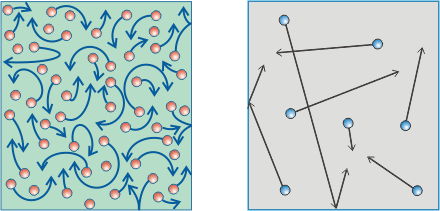 |
NO ME SALEN
(THEORETICAL NOTES OF BIOPHYSICS)
FLUIDS
GENERAL |
|
|

|
| |
We’re, somehow, a walking pipe system. On the inside, we’re full of tubes, hoses, bags, tanks and another huge load of anatomical stuff filled up with FLUIDS. So, if we wish to understand how does the human body, or any other animal body works, we have no choice but to study the laws and properties of these fluids.
I’ll show you two of the commonest fluids: liquids ands gases. The diagrams might be a little rough, but still useful. |
 |
|
|
Liquids. Material systems where molecules “roll” over one another. Distance between molecules tend to be relatively small and similar to solids; therefore densities tend to be similar between both and hundreds of times higher than gases. They are practically (Incomprensibles): they generally have a well defined volume, though not a shape. |
|
Gases. Material systems on which molecules move freely, rarely interacting between them. They rarely crash, except against the walls of the recipient when there is one. Distances amongst molecules are much larger than those in liquids and solids, therefore gases tend to have very low densities. |
|
|
|
A common important feature on fluids is that their molecules move in a rather chaotic way; speeds are rarely uniform, neither in (agnitude nor in direction nor in sense. Even when you see a liquid stand absolutely still, like a glass of water on a table, their molecules are in a non-stopping movement. |
|
|
| IMPORTANT GOSSIP: |
|
|
- 75% of the human weight is water.
- An adult has a blood volume of 5 litres.
- In an inspiration, lungs hold up to 6 litres of air [TLC, Total Lung Capacity].
- The non-stopping movement of molecules in a quiet fluid is called brownian motion, in honor to british botanist Robert Brown, who first observed it by putting small pollen grains on water under a microscope.
- Liquids which can’t mix, like water and oil, are called immiscible. There ar no immiscible gases, except for some oddities.
|
|
|
TRICKY QUESTION: |
|
 |
|
|
| |
|
| Translated by Matías Varela. Some rights reserved.
Be copied by quoting the source. Last updated
sep-07. Buenos Aires, Argentina. |
|
|
| | |
|
|
